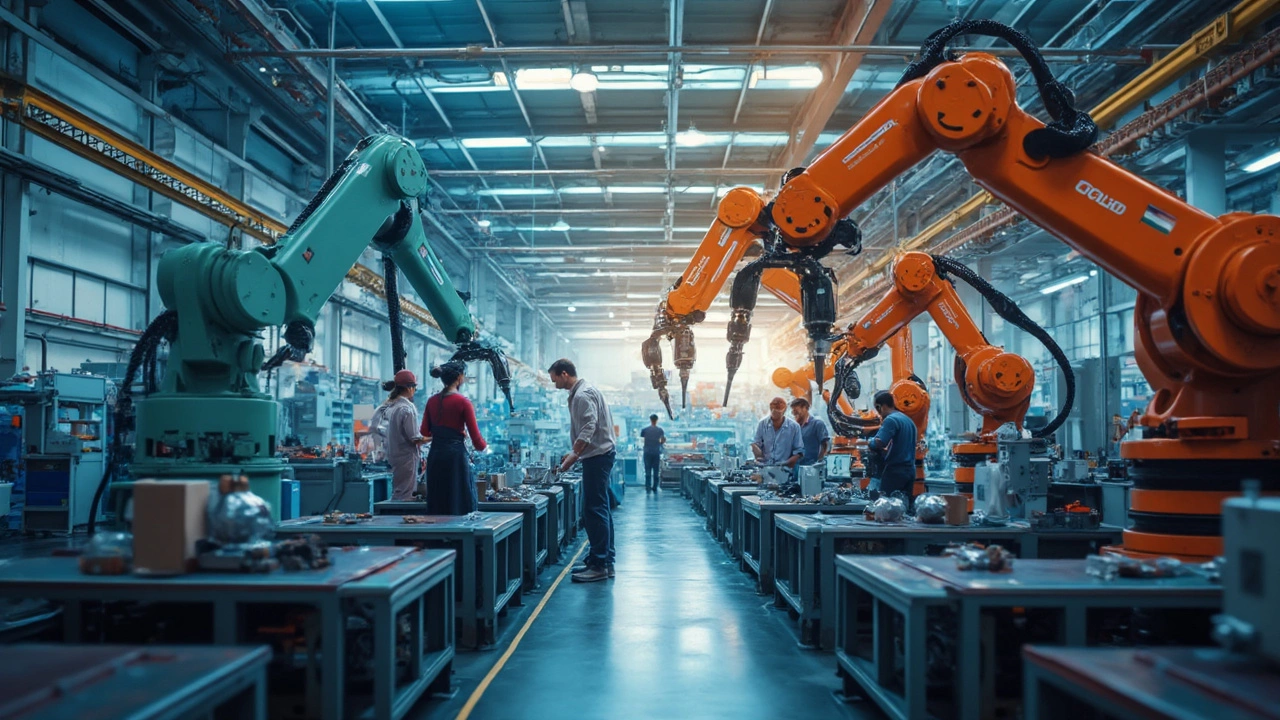Is There a Manufacturing Boom in the U.S.?

So, what’s going on with manufacturing in the U.S. right now? A lot more than you might think. Manufacturing seems to be hitting an upswing, almost like a revival. But what's really kicking this into gear? Behind the scenes, there are some smart government moves and tech breaks changing the game.
First off, we need to talk about government schemes that are backing this boom. There have been some strong pushes for keeping industries home-grown. Policies aiming to boost domestic production are influencing companies to reconsider offshore operations. It feels a bit like a game of chess, where the strategies aim to strengthen local industries against global competition.
- The Current State of U.S. Manufacturing
- Government Schemes and Policies
- Technological Advances Fueling Growth
- Impact on the Workforce
- Challenges and Future Outlook
The Current State of U.S. Manufacturing
The American manufacturing sector is definitely doing some heavy lifting lately. After years of seeing factories move overseas, there's been a noticeable shift. The sector's output has been climbing, thanks in part to new policies encouraging local production.
Right now, around 12.5 million people have manufacturing jobs, which is a nice jump compared to a few years back. One big driver here is the manufacturing boom spurred on by efforts to bring back jobs to the U.S. Companies are getting incentives to stick around, and that's showing in the job market and the economy.
What's more? There’s been an uptick in investment, particularly in technology and infrastructure, pushing the sector even further. The focus isn't just on churning out more products—it's also about making them better and faster. So, factories are getting tech makeovers with things like automation and sustainable practices playing big roles.
| Year | Manufacturing Jobs (in millions) | Total Output (in $ billions) |
|---|---|---|
| 2020 | 11.8 | 2,200 |
| 2023 | 12.3 | 2,450 |
| 2025 | 12.5 | 2,600 |
It's important to recognize that this growth is not uniform across the board. Some states, especially in the Midwest and the South, are benefiting more because of existing infrastructure and investment in new technologies. But overall, it seems like the U.S. is getting ready to reclaim its spot as a major player in global manufacturing.
Government Schemes and Policies
Let’s get into what Uncle Sam is doing to boost U.S. manufacturing. Over the last few years, the American government has rolled out some serious initiatives aiming to breathe new life into manufacturing. Remember the Infrastructure Investment and Jobs Act? It poured billions into upgrading roads, bridges, and more, creating a bedrock for manufacturing to thrive.
Then there’s the focus on cutting-edge stuff. The CHIPS Act is a biggie—it aims to beef up domestic R&D and production of semiconductors. These little chips are super important for everything from cars to smartphones. The goal? Make sure America is not lagging when it comes to tech manufacturing, which is pretty much the backbone of so many industries today.
The government's also keen on reshoring, which is a fancy way of saying bringing jobs back to the U.S. Tax incentives and subsidies are on the table for companies setting up or expanding local facilities. Honestly, with the global supply chain hiccups we've seen, keeping things closer to home makes a lot of sense.
Additionally, there’s a push for something called “Buy American.” It’s part of an executive order that wants federal agencies to buy more U.S.-made goods. This policy alone could stimulate a lot of local production as federal procurement is a big customer.
- Tax credits for clean energy manufacturing
- Grants for small and medium manufacturers
- Workforce training programs
Is it a perfect system? Not quite. There are still challenges like high costs and skill gaps. But these schemes are big steps toward a manufacturing boom. We're talking job creation, technological leadership, and economic resilience. The key is keeping these plans going and adapting to the inevitable changes in the global economy.
| Policy | Impact |
|---|---|
| CHIPS Act | Boosts semiconductor production |
| Buy American | Increases demand for domestically made goods |

Technological Advances Fueling Growth
Technology is like the secret sauce that's been ramping up the U.S. manufacturing scene lately. If you’ve been hearing about terms like AI, automation, and 3D printing tossed around, they're not just buzzwords—they're actually at the core of this manufacturing boom.
Take AI and automation, for instance. They’re reshaping how factories function by making processes faster and cutting down on errors. Imagine robots handling tasks that used to take a whole crew of humans. This not only saves time but also money, and while it might sound like science fiction, it's the reality on many American production lines today.
Then there’s 3D printing or additive manufacturing, as it's sometimes called. It's not just for making prototypes anymore. Companies are producing actual products at warp speed and with less waste. It's all about being more efficient and flexible—two things that are key in keeping U.S. manufacturing competitive.
Another big player is the use of data analytics. Factories are now using real-time data to make instant decisions, fixing issues on the fly and adapting to changes swiftly. This kind of agility is crucial in a fast-paced market.
| Technology | Impact on Manufacturing |
|---|---|
| AI and Automation | Increased efficiency and reduced errors |
| 3D Printing | Faster production and less waste |
| Data Analytics | Real-time decision making |
Of course, these technologies aren’t without their challenges. They require a skilled workforce, and that means training people for jobs that didn’t exist a decade ago. But on the flip side, they’re creating new roles, redefining the workforce, and boosting overall productivity.
Impact on the Workforce
The manufacturing boom in the U.S. is shaking things up for the workforce in ways both exciting and challenging. Thanks to expanding U.S. manufacturing, there’s a rush of new job opportunities cropping up across the country. But while this sounds like a job-seeker's dream, there's more to the story.
First off, with all this growth, there is a higher demand for skilled labor. The days of simple assembly lines are evolving into tech-heavy, sophisticated production methods. That's where a big gap emerges. The sector needs skilled operators and technicians familiar with automation, robotics, and IoT technologies. So, there’s a push for training programs and certifications to get workers up to speed.
Then there's the matter of wages. With the current boom, wages in key manufacturing sectors are seeing an uptick. Companies are competing to attract and retain top talent with better pay and perks. This isn't just good news for folks in the manufacturing sector, but it can also drive a ripple effect, helping to stabilize and increase wages in other industries too.
However, it's not all smooth sailing. Automation, while creating many jobs, is also a double-edged sword, displacing some traditional roles. Workers need to adapt quickly to survive in this fast-changing environment. Fortunately, government initiatives and private sector collaborations are providing pathways for reskilling.
To better understand these shifts, here’s a quick snapshot:
| Year | Manufacturing Jobs Added |
|---|---|
| 2023 | 80,000 |
| 2024 | 95,000 |
| 2025 (estimated) | 110,000 |
This growth not only hints at a brighter economic horizon but also underscores the critical need for comprehensive workforce training programs to sustain it.

Challenges and Future Outlook
Diving into the world of U.S. manufacturing, it's clear that it's not all smooth sailing. Even with all the buzz about a manufacturing boom, there are some bumps in the road. First up, the global supply chain issues we saw during the pandemic have left their mark. Companies are still struggling with sourcing materials, which can slow things down a bit.
Another sticky spot is the workforce. There’s a real need for skilled workers, but the gap between tech demands and available skills is wider than anyone would like. Many factories need workers who are savvy with complex tech equipment, but it’s not always easy to find them. Training programs are trying to catch up, but it's a race against time.
Now, let’s talk about technology. Sure, it’s great and all, but it doesn’t come cheap. Investing in cutting-edge tech can be a steep climb for some smaller manufacturers. Those without deep pockets might find themselves lagging, unable to keep up with the big guys who can afford to splash out on the latest equipment.
As for the future outlook, it’s kind of a mixed bag. If government schemes keep pushing policies that favor local production, we might see more momentum build up. But it’ll all depend on how adaptable these companies can be in tweaking their operations to fit the ever-evolving market demands.
- Focus on enhancing worker skills through more accessible training programs.
- Encourage investment in new technology with grants or subsidies.
- Develop better risk management for supply chain disruptions.
There's potential for growth in U.S. manufacturing, no doubt. Getting past these hurdles could mean a bright and booming future for the industry. But much like a rollercoaster, there might be some thrills and drops along the way.





